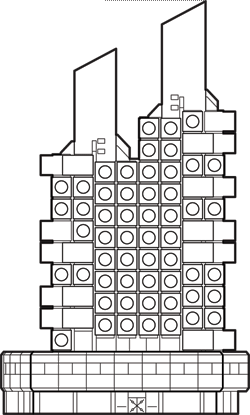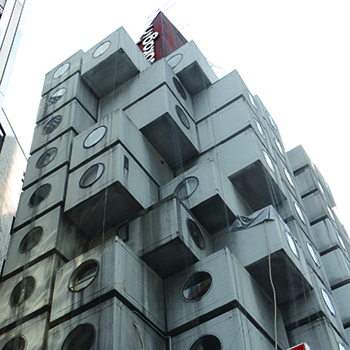Nakagin Capsule Tower
Tokyo
- CTBUH Drawing
- Facts
-
Metrics
You must be a CTBUH Member to view this resource.
To Tip:
Height is measured from the level of the lowest, significant, open-air, pedestrian entrance to the highest point of the building, irrespective of material or function of the highest element (i.e., including antennae, flagpoles, signage and other functional-technical equipment).Architectural:
Height is measured from the level of the lowest, significant, open-air, pedestrian entrance to the architectural top of the building, including spires, but not including antennae, signage, flag poles or other functional-technical equipment. This measurement is the most widely utilized and is employed to define the Council on Tall Buildings and Urban Habitat (CTBUH) rankings of the "World's Tallest Buildings."Above Ground
The number of floors above ground should include the ground floor level and be the number of main floors above ground, including any significant mezzanine floors and major mechanical plant floors. Mechanical mezzanines should not be included if they have a significantly smaller floor area than the major floors below. Similarly, mechanical penthouses or plant rooms protruding above the general roof area should not be counted. Note: CTBUH floor counts may differ from published accounts, as it is common in some regions of the world for certain floor levels not to be included (e.g., the level 4, 14, 24, etc. in Hong Kong).Below Ground
The number of floors below ground should include all major floors located below the ground floor level.
Official Name
Nakagin Capsule Tower
Type
Building
Status
Under Demolition
Completion
1972
Country
City
Address
Function
A mixed-use tall building contains two or more functions (or uses), where each of the functions occupy a significant proportion of the tower's total space. Support areas such as car parks and mechanical plant space do not constitute mixed-use functions. Functions are denoted on CTBUH "Tallest Building" lists in descending order, e.g., "hotel/office" indicates hotel function above office function.
Serviced Apartments / Office / Retail
Height
54 m / 177 ft
Floors Above Ground
13
Floors Below Ground
1
# of Apartments
140
Tower GFA
3,091 m² / 33,271 ft²
Construction Schedule
Construction Start
Completed
Demolished
You must be a CTBUH Member to view this resource.
Owner/Developer
Nakagin Group
Architect
Usually involved in the front end design, with a "typical" condition being that of a leadership role through either Schematic Design or Design Development, and then a monitoring role through the CD and CA phases.
Kisho Kurokawa Architects & Associates
Research

28 April 2015
Debating Tall: Should Nakagin Capsule Tower Be Preserved?
Erez Golani Solomon, Waseda University; Christian Dimmer, University of Tokyo
The Nakagin Capsule Tower, designed by Kisho Kurokawa and constructed in 1972, is an emblem of the Metabolism movement. With built-in features such as telephones,...
Global News
terri-meyer-boake1.jpg)
15 April 2022
Demolition of Capsule Tower Begins in Tokyo
The dismantling of the metabolist Nakagin Capsule Tower in Tokyo has begun, with the interiors of its modular capsule homes already resembling a "demolition site."...
Global News
terri-meyer-boake1.jpg)
15 April 2022
Demolition of Capsule Tower Begins in Tokyo
The dismantling of the metabolist Nakagin Capsule Tower in Tokyo has begun, with the interiors of its modular capsule homes already resembling a "demolition site."...
terri-meyer-boake1.jpg)
04 April 2022
Tokyo's Historic Metabolism Movement Tower to be Demolished
The futuristic-looking Nakagin Capsule Tower in Tokyo will be demolished in April, 2022 its owners say, after a long battle to save the building and...

27 April 2021
Iconic Tokyo Capsule Tower to be Sold
The iconic Nakagin Capsule Tower building in Ginza is reaching the final stages of its saga as the capsule owners have voted in favor to...

12 August 2019
Iconic Tokyo Tower Could be Saved
Tokyo’s Nakagin Capsule Tower apartment building, a surviving icon of Japan’s Metabolism movement in the 1970s, may soon have a savior from its impending demolition,...
Subscribe below to receive periodic updates from CTBUH on the latest Tall Building and Urban news and CTBUH initiatives, including our monthly newsletter. Fields with a red asterisk (*) next to them are required.
View our privacy policy













































